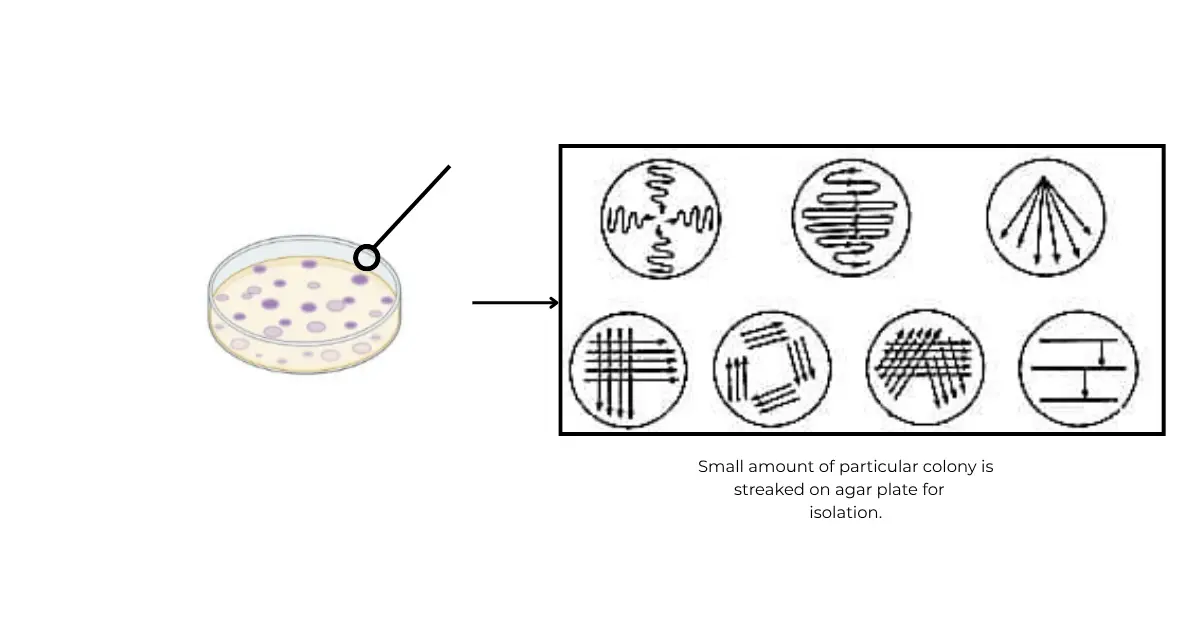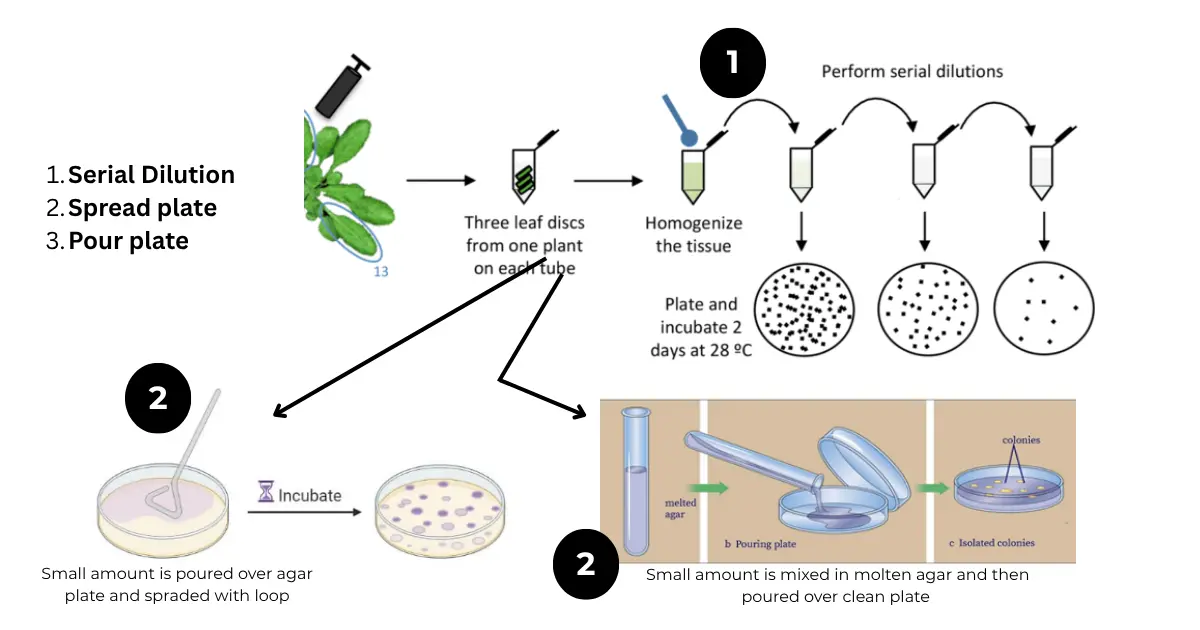Isolation, Purification, and Culture Methods of Microbes is important foundational technique in microbiology. These techniques allow us to study microbes in pure form, essential for diagnostics, research, and industrial applications. Isolation separates a specific microbe from a mixed population; purification ensures the culture is free from contaminants; and culture methods enable the growth and study of microbes under controlled conditions.
Let’s say, you wanted to get a bacteria that have plant growth promotion from soil.
How will you do it?
Practically we cannot see it and the soil may contain thousand of different types of microbes. Here comes our first method that is isolation, we will get many cultivable colony (population of single type of bacteria) on artificial medium.
The technique used for isolation vary depending upon what group of microbes we are aim to isolate, for example here we wanted to isolate bacteria which have plant growth promotion ability.
Isolation of Bacteria
Bacteria are found in diverse habitats, including soil, water, air, food, inside the body and outside the body (blood, urine, and wound exudates). Isolation aims to obtain a single type of bacterium from such mixed sources, enabling its identification and further analysis.
1. Sample Collection
A sample refers to the portion of material—such as soil, water, clinical fluid, or tissue—collected from an environment or organism for the purpose of microbial isolation and analysis.
Proper sampling is a critical first step, as the accuracy and reliability of downstream results depend heavily on how, where, and under what conditions the sample is collected.
It is essential that samples are collected using sterile techniques and transported under appropriate conditions to prevent contamination or loss of microbial viability.
These are some of the sample collection technique –
- Sterile Swabs are commonly used for collecting samples from skin, throat, or wounds.
- Blood Culture Bottles detect bacteria in bloodstream infections.
- Water and Sewage Filtration concentrates bacteria by trapping them on a membrane filter, which is then transferred to a culture medium.
the type of sample collection depends on what and where our desired organism present. for example if we wanted to isolate bacteria from the body surface the sterile swabs would be a good choice.
2. Streak Plate Method
This surface isolation technique involves streaking an inoculum over the surface of an agar plate using a sterile loop. The pattern—usually quadrant or zigzag—dilutes the sample across the plate, allowing individual bacterial cells to grow into separate, visible colonies. It is one of the most common methods for obtaining pure cultures.

3. Spread Plate Method
In this technique, a small volume of diluted microbial sample is placed on the surface of a solid agar plate and evenly spread using a sterile glass spreader (often called a “hockey stick”). This method is especially useful for isolating aerobic organisms and obtaining well-separated colonies for enumeration or further culturing.
4. Pour Plate Method
Here, the diluted sample is mixed with molten agar and poured into a Petri dish. As the agar solidifies, bacteria are trapped both within and on the surface, allowing colonies to develop throughout the medium. It’s useful for isolating and quantifying organisms from liquid samples.
5. Serial Dilution Method
This is a quantitative approach in which the microbial sample is serially diluted, and aliquots are plated to obtain countable colonies. It is particularly useful for estimating bacterial load in samples like milk, water, or food.

If you are here, then you are already covered major part of the article. and if you like it, please follow and comment. What is your opinion.
Isolation of Viruses
Viruses cannot grow on standard culture media like other microorganisms because they are obligate intracellular parasites—they require a living host cell to replicate.
Therefore, virus isolation involves not only the collection of appropriate samples but also the use of biological systems—such as living cells, tissues, or whole organisms—that can support viral replication.
The first step is sample collection, which depends on the nature of the suspected virus.
See the following example for collection-
- Respiratory viruses e.g. corona: Collected from nasal or throat swabs.
- Blood-borne viruses e.g. Hepatitis: Obtained from serum/plasma.
- Gastrointestinal viruses e.g. rotavirus: Found in stool samples.
It is critical to handle these samples under sterile conditions and transport them quickly to maintain viral integrity.
Isolation
- Following collection, viruses are introduced into suitable host systems. One of the most common methods is cell culture, where viruses are grown in monolayers of animal or human cell lines such as HeLa, Vero, or MDCK cells.
- Some viruses, particularly influenza and poxviruses, can also be propagated in embryonated chicken eggs, which offer a complex but natural environment for viral replication.
- In certain cases, especially for neurotropic viruses like rabies, laboratory animals are used for viral propagation, although ethical and regulatory concerns limit this practice.
To confirm the presence of virus and quantify infectious particles, a plaque assay is often performed. In this technique, a diluted virus sample is applied to a monolayer of host cells. As the virus infects and lyses cells, it creates clear zones called plaques, each of which originates from a single infectious viral particle. Counting these plaques provides a direct measure of viral concentration in the sample.
Isolation of Fungi
Fungi are ubiquitous in nature and can be isolated from a variety of sources, including soil, water, food, plant material, and clinical specimens. Unlike viruses, fungi grow readily on artificial media and do not require living cells for propagation, though they may have specific nutrient or environmental preferences.
Sample collection and processing
- Skin Scrapings: Used for dermatophytes (e.g., ringworm).
- Soil and Water Samples: Contain environmental fungi like Penicillium and Rhizopus.
Proper handling, including sterile techniques and immediate culturing or storage, is vital to preserve fungal viability and avoid contamination.
Now the next step is to transfer the collected sample into proper medium so that fungi can grow and can be then isolate properly. Fungal isolation heavily relies on the use of selective and differential media.
some of the medium are,
- Sabouraud Dextrose Agar (SDA) is one of the most commonly used media; its slightly acidic pH and addition of antibiotics help inhibit bacterial growth while promoting fungal proliferation.
- Potato Dextrose Agar (PDA) is particularly supportive of mold growth and is widely used in food and plant microbiology.
- Corn Meal Agar, on the other hand, is useful for identifying yeast species, especially based on morphological characteristics such as hyphae, chlamydospores, and budding patterns.
We have already discussed different growth media in our previous article check this if you have not read it. –
Also read: Growth Medium for microbes.
Purification of Microbes
After isolation, the resulting culture may still have unwanted microorganisms. Purification ensures that only a single bacterial species is present.
This typically involves picking well-isolated colonies from an agar plate and re-streaking them on fresh medium. The process may be repeated multiple times until purity is confirmed.
Morphological traits, such as colony shape, color, and texture, help in selecting colonies for purification. Aseptic techniques are important throughout the experiment to prevent contamination.
Culture Methods of Microbes
Culturing is the process of growing microorganisms under controlled conditions, allowing their study, identification, and application. Culture methods vary depending on the goals of the experiment and the nature of the organism.
- Batch Culture
This is a closed system in which microbes grow in a fixed volume of medium. Nutrients are gradually depleted, and waste accumulates, resulting in a typical growth curve (lag, exponential, stationary, and death phases). Batch cultures are commonly used in laboratory experiments and small-scale fermentations. - Continuous Culture
Continuous cultures maintain microbial growth in a steady state. In systems like the chemostat, fresh medium is continuously supplied while spent culture is removed at the same rate. This keeps the cell population and nutrient levels constant, ideal for long-term studies and industrial production. - Specialized Growth Conditions
Some microbes require specific conditions or media:- Fastidious organisms need enriched media supplemented with blood, vitamins, or amino acids.
- Obligate anaerobes must be cultured in oxygen-free environments using anaerobic jars or chambers.
- Thermophiles, halophiles, or acidophiles require extreme conditions that mimic their natural habitats.
Organisms like Escherichia coli grow well on general-purpose media and are frequently used in teaching and research.
Do Share and comment your thoughts.
